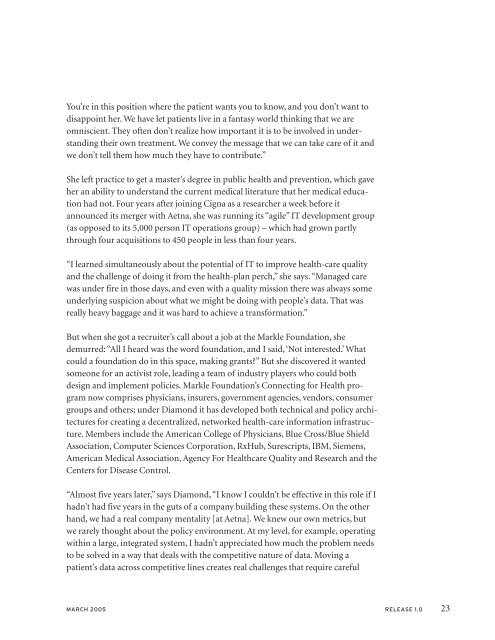The World Wide World: IT Ain't Just the Web ... - Cdn.oreilly.com
The World Wide World: IT Ain't Just the Web ... - Cdn.oreilly.com
The World Wide World: IT Ain't Just the Web ... - Cdn.oreilly.com
Create successful ePaper yourself
Turn your PDF publications into a flip-book with our unique Google optimized e-Paper software.
You’re in this position where <strong>the</strong> patient wants you to know, and you don’t want to<br />
disappoint her. We have let patients live in a fantasy world thinking that we are<br />
omniscient. <strong>The</strong>y often don’t realize how important it is to be involved in understanding<br />
<strong>the</strong>ir own treatment. We convey <strong>the</strong> message that we can take care of it and<br />
we don’t tell <strong>the</strong>m how much <strong>the</strong>y have to contribute.”<br />
She left practice to get a master’s degree in public health and prevention, which gave<br />
her an ability to understand <strong>the</strong> current medical literature that her medical education<br />
had not. Four years after joining Cigna as a researcher a week before it<br />
announced its merger with Aetna, she was running its “agile” <strong>IT</strong> development group<br />
(as opposed to its 5,000 person <strong>IT</strong> operations group) – which had grown partly<br />
through four acquisitions to 450 people in less than four years.<br />
“I learned simultaneously about <strong>the</strong> potential of <strong>IT</strong> to improve health-care quality<br />
and <strong>the</strong> challenge of doing it from <strong>the</strong> health-plan perch,” she says. “Managed care<br />
was under fire in those days, and even with a quality mission <strong>the</strong>re was always some<br />
underlying suspicion about what we might be doing with people’s data. That was<br />
really heavy baggage and it was hard to achieve a transformation.”<br />
But when she got a recruiter’s call about a job at <strong>the</strong> Markle Foundation, she<br />
demurred: “All I heard was <strong>the</strong> word foundation, and I said, ‘Not interested.’ What<br />
could a foundation do in this space, making grants?” But she discovered it wanted<br />
someone for an activist role, leading a team of industry players who could both<br />
design and implement policies. Markle Foundation’s Connecting for Health program<br />
now <strong>com</strong>prises physicians, insurers, government agencies, vendors, consumer<br />
groups and o<strong>the</strong>rs; under Diamond it has developed both technical and policy architectures<br />
for creating a decentralized, networked health-care information infrastructure.<br />
Members include <strong>the</strong> American College of Physicians, Blue Cross/Blue Shield<br />
Association, Computer Sciences Corporation, RxHub, Surescripts, IBM, Siemens,<br />
American Medical Association, Agency For Healthcare Quality and Research and <strong>the</strong><br />
Centers for Disease Control.<br />
“Almost five years later,” says Diamond, “I know I couldn’t be effective in this role if I<br />
hadn’t had five years in <strong>the</strong> guts of a <strong>com</strong>pany building <strong>the</strong>se systems. On <strong>the</strong> o<strong>the</strong>r<br />
hand, we had a real <strong>com</strong>pany mentality [at Aetna]. We knew our own metrics, but<br />
we rarely thought about <strong>the</strong> policy environment. At my level, for example, operating<br />
within a large, integrated system, I hadn’t appreciated how much <strong>the</strong> problem needs<br />
to be solved in a way that deals with <strong>the</strong> <strong>com</strong>petitive nature of data. Moving a<br />
patient’s data across <strong>com</strong>petitive lines creates real challenges that require careful<br />
MARCH 2005 RELEASE 1.0 23
















